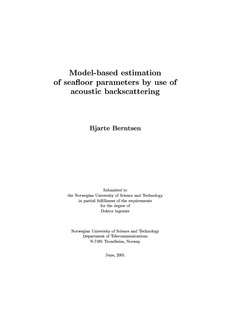| dc.contributor.author | Berntsen, Bjarte | nb_NO |
| dc.date.accessioned | 2014-12-19T13:42:37Z | |
| dc.date.accessioned | 2015-12-22T11:39:49Z | |
| dc.date.available | 2014-12-19T13:42:37Z | |
| dc.date.available | 2015-12-22T11:39:49Z | |
| dc.date.created | 2008-05-08 | nb_NO |
| dc.date.issued | 2001 | nb_NO |
| dc.identifier | 124311 | nb_NO |
| dc.identifier.isbn | 82-471-5326-2 | nb_NO |
| dc.identifier.uri | http://hdl.handle.net/11250/2368819 | |
| dc.description.abstract | An algorithm for characterization of the seafloor by use of a parametric acoustic source has been developed. It is called FARIM – Frequency Analysis based Roughness and Impedance estimation method. The work was done within the ISACS MAST III project. ISACS ia an acronym for Integrated System for Analysis and Characterization of the Seafloor.
The properties of a monostatic sonar system has been investigated, and the different processes identified and studied.
Various approaches to classification and characterization have been studied, and the necessary theory for understanding the developed characterization technique is presented in this thesis. A model-based approach was chosen, in order to improve the understanding of the problem and obtain a robust and traceable characterization method. The Kirchhoff theory was chosen for modelling the scattering from the seafloor.
The characterization algorithm itself is described. Changes in the frequency distribution as the roughness increases is used for estimating the roughness, as the low frequency components are less influenced by roughness. The energy of the return is uses for estimating the impedance of the seafloor, while correcting for the estimated roughness and near-field effects of the parametric source and possible also for the seafloor bathymetry.
Sensitivity analysis indicates that good estimation of seafloor roughness and impedance should be feasible, assuming moderate roughness compared to the probing wavelength. The chosen characterization features (center-of-gravity of the power spectrum and the energy of the return) are rather insensitive to most parameters of the chosen seafloor description. However, the features are relatively sensitive to the high-pass cut-off frequency of the power spectrum for the seafloor roughness, and it should be further studied. Stacking is shown to improve the parameter estimation.
The algorithm was tested on both synthetic and field data. The test on synthetic data was done both to verify the numerical implementation of the algorithm and to study the accuracy. The test showed excellent agreement between real values and the estimates, when the roughness was moderate and suitable error estimates as reliable indicators of the accuracy of the estimates were found.
Field data from the Mediterranean, North Sea and Baltic have been analyzed. The estimates show very good agreement with the available ground truth data. We feel however that still more work should be done to verify the estimation technique on field data.
The estimation technique is numerically very quick, and the calculations can be done in real time.
A parametric source ha been found to be suitable for use with characterization technique, and the field data analyzed in this report was acquired with a parametric sonar. | nb_NO |
| dc.language | eng | nb_NO |
| dc.publisher | Fakultet for informasjonsteknologi, matematikk og elektroteknikk | nb_NO |
| dc.relation.ispartofseries | Dr. ingeniøravhandling, 0809-103X; 2001:62 | nb_NO |
| dc.title | Model-Based Estimation of Seafloor Parameters by use of Acoustic Backscattering | nb_NO |
| dc.type | Doctoral thesis | nb_NO |
| dc.contributor.department | Norges teknisk-naturvitenskapelige universitet, Fakultet for informasjonsteknologi, matematikk og elektroteknikk, Institutt for elektronikk og telekommunikasjon | nb_NO |
| dc.description.degree | dr.ing. | nb_NO |
